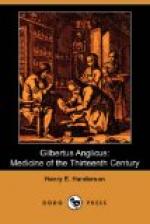“Mark here a chapter on the cure of stone in the bladder by means of surgery, which we have omitted above. Accordingly, to determine whether a stone exists in the bladder, let the patient take a warm bath. Then let him be placed with his buttocks elevated, and, having inserted into the anus two fingers of the right hand, press the fist of the left hand deeply above the pubes and lift and draw the entire bladder upward. If you find anything hard and heavy, it is manifest that there is a stone in the bladder. If the body feels soft and fleshy, it is a fleshy excrescence (carnositas), which impedes the flow of urine. Now, if the stone is located in the neck of the bladder and you wish to force it to the fundus: after the use of fomentations and inunctions, inject through a syringe (siringa) some petroleum, and after a short interval pass the syringe again up to the neck of the bladder and cautiously and gently push the stone away from the neck to the fundus. Or, which is safer and better, having used the preceding fomentations and inunctions, and having assured yourself that there is a stone in the bladder, introduce your fingers into the anus and compress the neck of the bladder with the fist of the left hand above the pubes, and cautiously remove the stone and guide it to the fundus. But if you wish to extract the stone, let a spare diet precede the operation, and let the patient lie abed for a couple of days with very little food. On the third day introduce the fingers into the anus as before, and draw down the stone into the neck of the bladder. Then make your incision lengthwise in the fontanel, the width of two fingers above the anus, and extract the stone. For nine days after the operation let the patient use, morning and evening, fomentations of branca (acanthus mollis), paritaria (pellitery) and malva (mallows). A bit of tow (stupa) moistened with the yolk of egg in winter, and with both the yolk and white of egg in summer, is to be placed over the wound. Proud flesh, which often springs up near a wound in the neck of the bladder, should be removed by the knife (rasorio), and two or three sutures inserted. The wound is then to be treated like other wounds. It should be remarked, however, that if the stone is very large, it should be simply pushed up to the fundus of the bladder and left there, and no effort should be made to extract it.”
This description of the diagnosis of stone and of the operation of lithotomy is copied almost literally from Roger of Parma.
Sufficient (perhaps more than enough) has been written to give the reader a fair idea of the general character of Gilbert’s “Compendium Medicine.”
A few words may be added with reference to the proper place of the work in our medical literature.
It is not difficult, of course, to select from the Compendium a charm or two, a few impossible etymologies and a few silly statements, to display these with a witty emphasis and to draw therefrom the easy conclusion that the book is a mass of crass superstition and absurd nonsense. This, however, is not criticism. It is mere caricature.




